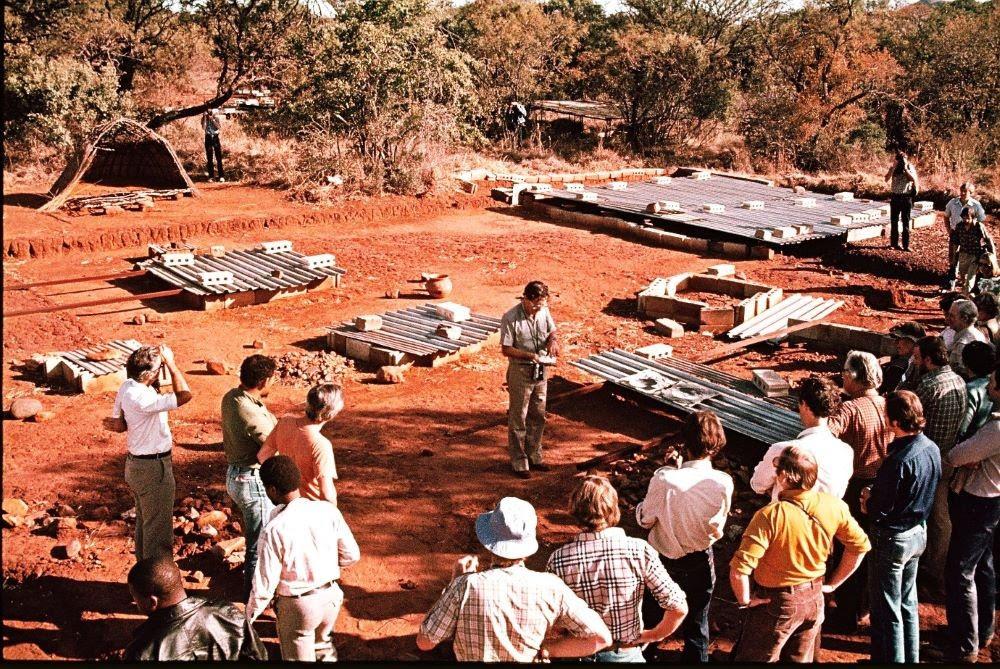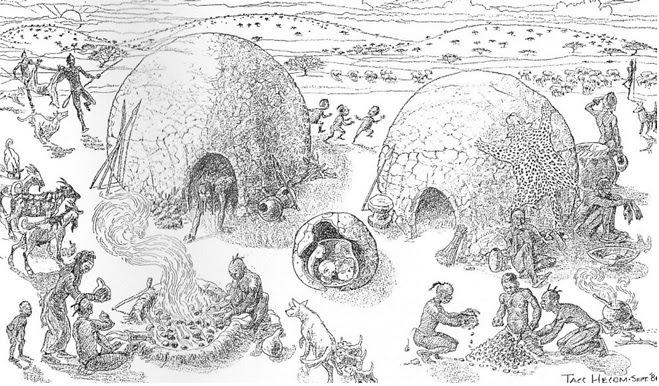
Disclaimer: Any views expressed by individuals and organisations are their own and do not in any way represent the views of The Heritage Portal. If you find any mistakes or historical inaccuracies, please contact the editor.
On the southern bank of Hartbeespoort Dam lies the archaeological site of one of the oldest farming and herding settlements in South Africa. It comprised several small interlinked homesteads and was first excavated by the pioneering Wits University archaeologist Revil Mason in the 1970s.
The inhabitants of this settlement at Broederstroom were the first Iron Age people in the area, and another leading archaeologist at Wits University, Tom Huffman, later used styles and patterns on potsherds from the site to trace their origins via the KwaZulu-Natal east coast through East Africa and back to the birthplace of the Bantu languages east of Nigeria. The site reveals that people were practicing agriculture, farming livestock, making pottery and smelting iron in South Africa 1,600 years ago. They brought with them the linguistic roots of the Bantu languages now spoken by 80 per cent of South Africans, and introduced methods of farming and animal husbandry that gave them considerable advantages over the Stone Age nomadic hunter-gatherer way of life that had, until then, existed in the region.
Farming and animal husbandry
The people of Broederstroom tilled the land and stored their produce in sealed underground pits lined with cattle dung. Methane gas from the dung lining of the pit controlled insect infestations, and grain stored in this way could last for several seasons. For daily use, grain was also kept in wicker storage bins raised on stones to keep out the damp.
Later Stone Age artifacts were found at the site, and it is probable that, as Stone Age culture declined in the face of Iron Age competition, these people were absorbed into, or subjugated by, the new settlers. The types of stone tools that have been recovered are similar to those found at Jubilee Cave elsewhere in the Magaliesberg and were used for scraping and preparing hides. Stone Age people probably worked as servants performing that type of task.
The arrangement of dwellings and cattle kraals shows that the male-dominated central cattle pattern was introduced into South Africa at this early stage, together with the concept of bride-wealth, lobola, which characterizes social structures, kinship, and power in many South African societies to this day. Cattle were central to the economy, and a number of social norms were implicit in the central cattle pattern. Society was ranked according to kinship, with hereditary male leadership. Women were associated with agriculture and crops, and grain bins were situated in the female areas of the settlement. People lived in small circular rondavel huts clustered around the central cattle kraal. Each hut was about 3m to 4m in diameter and was made of interwoven saplings plastered with clay under a conical thatched roof. Ritual burial of the dead was also practiced, and the bodies of important male personages were buried in the cattle kraal in keeping with the significance of cattle in the society. Cowrie shells found at the Broederstroom site indicate that some form of trade or exchange through middlemen was evidently taking place with people along the Indian Ocean coast where cowries were used as currency.
Iron was produced in three stages: mining, smelting, and forging. At Broederstroom ore was mined from surface deposits near the settlement. The miners took the ore to a smelting furnace where charcoal was brought to temperatures up to 1,500oC.
The metal bloom from the smelters was cooled and the metal-workers broke it up to separate the iron from unwanted slag and carbon. Metallurgical tests on an ingot block from Broederstroom showed that it had been cast by wrapping the pieces of impure iron in a fire-clay mold, and heating them in the furnace to weld them together and separate the remaining slag and charcoal contaminants. The mold would then have been removed from the fire and broken away to reveal the refined ingot, which was then taken to the forging furnaces for conversion into hoes, spears and other implements.
Five iron slag heaps have been unearthed at Broederstroom, suggesting that it was probably a fairly large production site. Smelting furnaces, as opposed to forges, have not been discovered, and may have been situated some distance away from the village. Few iron artifacts have been recovered; iron products could have been removed from the site by the people using them and cast aside to corrode away over thousands of years.
The Earliest Tswana settlement at Broederstroom 1500 years ago. The huts may have been shaped like those in the drawing. They were built by using clay plaster in place on the curved roof of the stick framework. Some of the huts had raised floors. Skulls of the ancestors were kept in a clay jar near the houses and the men were busy smelting iron ore in furnaces in front of the houses. The men on the right are preparing the brown spongy iron ore for smelting in the furnace. Domestic goats stand on the left of the picture. These were the earliest domestic animals to reach the Magaliesberg Valley. The men in the back of the picture are carrying a dead impala. These early Tswana people got much of their meat from hunting wild animals. Illustration and caption from Origins of the African People of the Johannesburg Area by Revil Mason (Johannesburg: Skotaville, 1987)
Extract from Cradle of Life by Vincent Carruthers (Struik Nature, 2019)
Main image: Revil Mason addressing visitors to the Toppieshoek site in 1980. Steel sheets protected the archaeological excavation from the elements and possible vandalism. (Wits Archaeology)
About the author: Vincent Carruthers has written several books including The Magaliesberg (four editions), Cradle of Life (2019) and The Wildlife of Southern Africa (three editions). In 2006 he initiated the project to have the Magaliesberg region declared a UNESCO Biosphere Reserve. He has received awards from various institutions including the University of the Witwatersrand Gold Medal in 2016 and the North West University Chancellor’s Medal in 2013. He has been CEO of WESSA, chairman of Birdlife South Africa and member of the North West Parks and Tourism Board. Currently retired from his management consultancy, he is enjoying writing for the Magaliesberg Association for Culture and Heritage.
Comments will load below. If for any reason none appear click here for some troubleshooting tips. If you would like to post a comment and need instructions click here.

